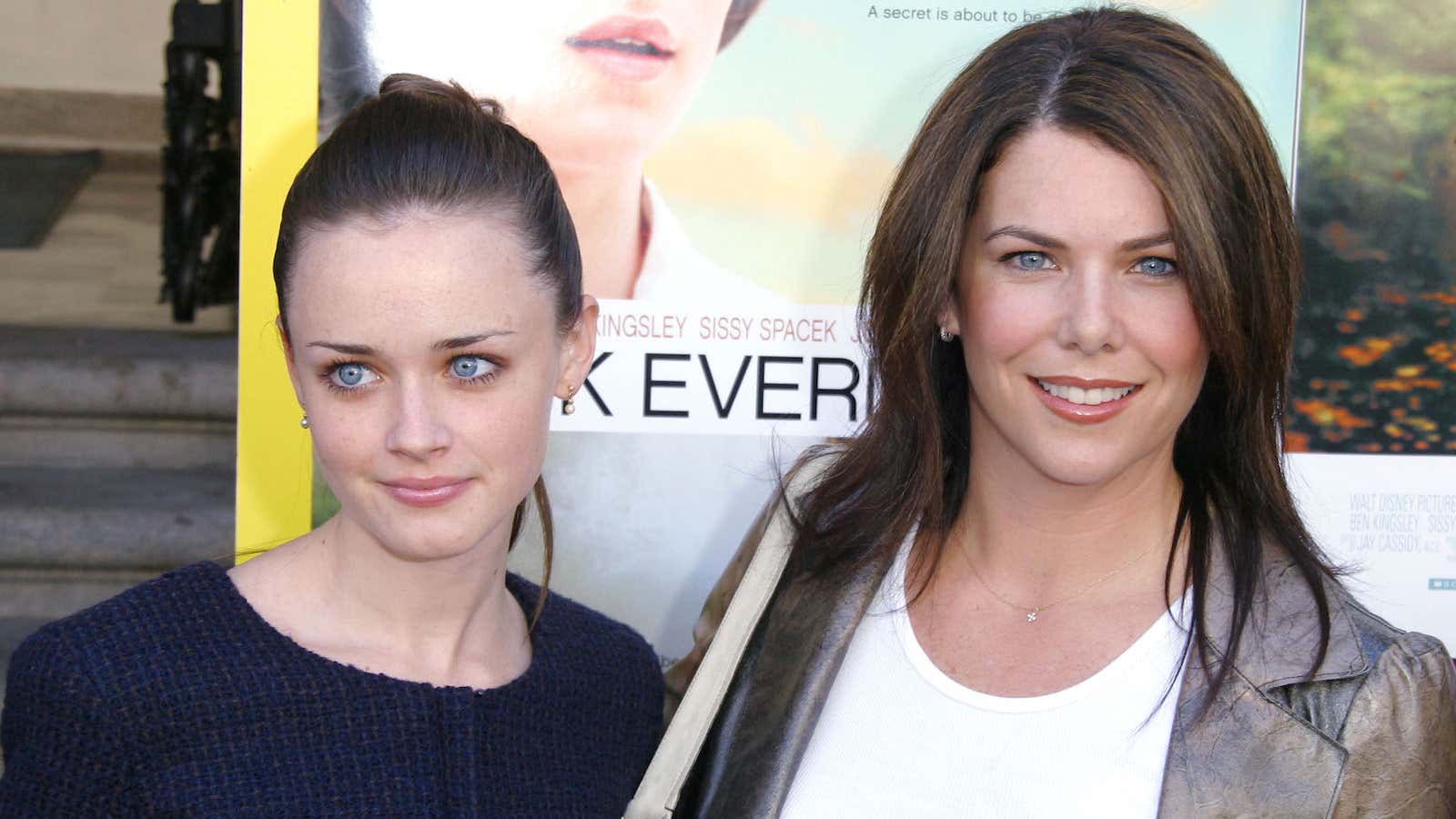When I was a teenager, I spent countless hours immersed in the life of a charming fictional town: Stars Hollow, Connecticut, the setting for the cult TV show Gilmore Girls. So when I heard about a fan festival to be held in Washington Depot, Connecticut—the village that inspired the series—I knew I had to go to fulfill my younger self’s fantasies.
But I never imagined that I’d find myself pulling an all-nighter in a beaver-themed lodge with Sean Gunn, the actor who plays the show’s resident oddball, Kirk. It was somewhere between 2 and 3 am, and I was surrounded by tree trunks poking out of the floor. Along with Gunn and another reporter, I was listening to John Cabrera, the actor and writer who played Gilmore Girls’ bass-playing geek Brian Fuller, explain his theory about what makes shows like Gilmore Girls garner legions of devoted fans.
Cabrera compared the series to a “genre show” like Game of Thrones—that is, a niche show, often with sci-fi or fantasy elements, that appeals to a particular viewer base. I had actually heard this parallel before from Alyssa Rosenberg, a TV critic at the Washington Post, who compared Gilmore Girls to the hit Joss Whedon series Buffy the Vampire Slayer.
Cabrera mused that shows like Gilmore Girls or Game of Thrones attract such obsessive fans because they successfully create a very specific, meticulously mapped world. Because these worlds have clear boundaries and rules, fans can form communities to explore them collectively, acting as “tourists.”
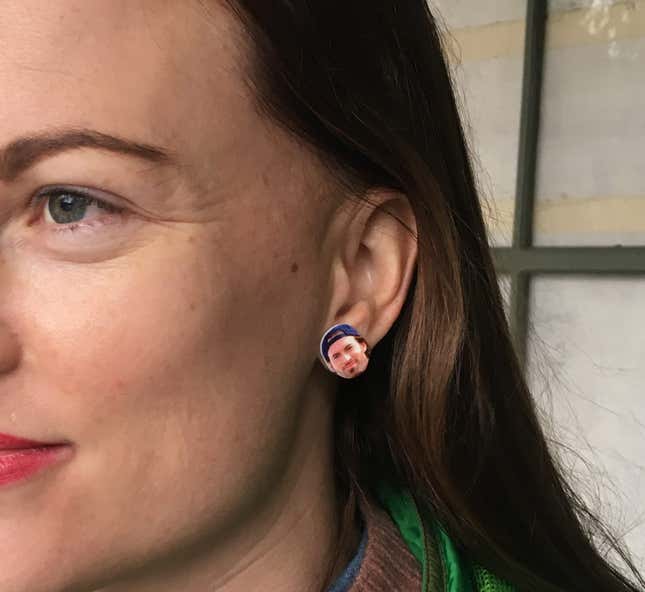
Typically, fans are limited to exploring these worlds via heated discussions or online forums. But the festival that we just had experienced was the ultimate form of tourism in a fantasy world—only in real life. This was what was so strange about a Gilmore Girls extravaganza set in the town that had inspired the show: it was life imitating art that had imitated life in the first place.
Through the looking glass
Gilmore Girls, which ran on the WB and then on the CW from 2000-2007, tells the story of the close-knit relationship between a young mother, Lorelai, and her teenage daughter, Rory. The pair live in a small, quirky town in Connecticut, surrounded by an array of charming weirdos. It’s an intensely reassuring, comfort-food kind of series. The stakes of each episode, devoted to town-hall meetings, school plays and slowly unfolding love triangles, are mundanely low.
The show is beloved among a fiercely loyal group of fans for its depiction of eccentric but ultimately loving relationships between family, friends and neighbors; its witty, lightning-fast dialogue; and an encyclopedic level of obscure pop culture references. When Netflix decided to make the show available for streaming in 2014, it rekindled audience’s intense love and introduced it to a new generation of devotees.
Because of the show’s renewed popularity, and widespread disappointment after its abrupt cancellation at the end of season seven, Netflix decided to invest in a four-episode revival, to be released Nov. 25. The festival, organized by a husband-and-wife PR company, was not affiliated with either Netflix or the CW. But amid the heightened excitement about the return of Stars Hollow to our screens, the timing was opportune.
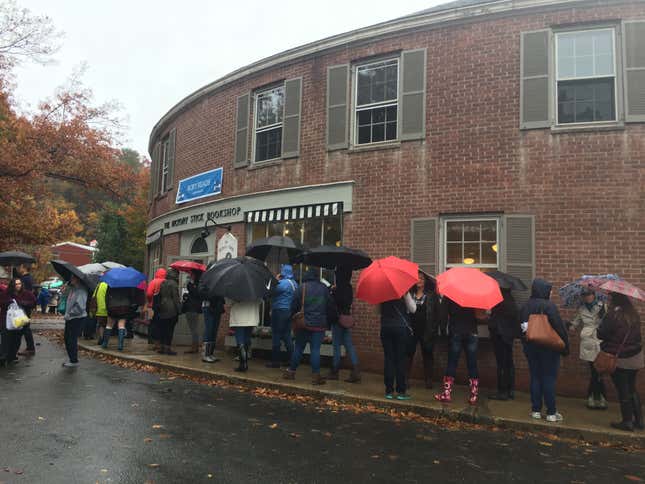
When I first arrived in Washington Depot, the village that inspired the show’s creator Amy Sherman Palladino, I was chilled to the bone, soaked by rain leaking through the door of my shabby old car. The apocalyptic, freezing downpour I had experienced on the drive up from New York City was not supposed to be a part of the Stars Hollow experience, where the weather is nearly always perfect. Television lied to me, I thought. This is bullshit. I worried it was a sign that the festival wouldn’t live up to my Gilmore Girls fantasy.
But then the sun shyly peeked out, illuminating Connecticut’s vibrant fall colors. And I soon found that the town’s main
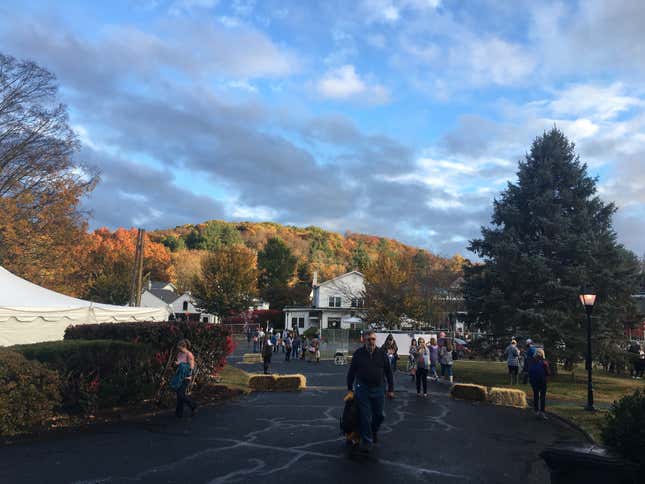
plaza bore a close resemblance to the idyllic Stars Hollow. The red-brick town hall brought to mind Rory’s public high school. The local grocery store resembled Doose’s, the tiny market where the Gilmore girls buy all their junk food. Among the few town establishments was a cozy bookstore called Hickory Stick, reminiscent of the shop where Rory stocks up on novels and holds a part-time job. The Mayflower Grace, a boutique hotel that served as inspiration for Lorelai’s first workplace, the Independence Inn, was just a few miles away. The world of Stars Hollow was in place, and we’d all climbed right inside it.
There was one big hole in the Stars Hollow illusion: Washington had no real-life equivalent of Luke’s Diner, the burger-and-fries joint where the town’s denizens convene under the watch of Luke himself, a kind-hearted, plaid-wearing grump.
The diner in Washington Depot closed years ago. But its former owner, Dawn Belanger—rumored to be the inspiration for the original character of Luke—said the show’s depiction of the diner as the social heart of the town was pretty accurate. “I could tell you exactly what they ate,” she said of her regular customers.
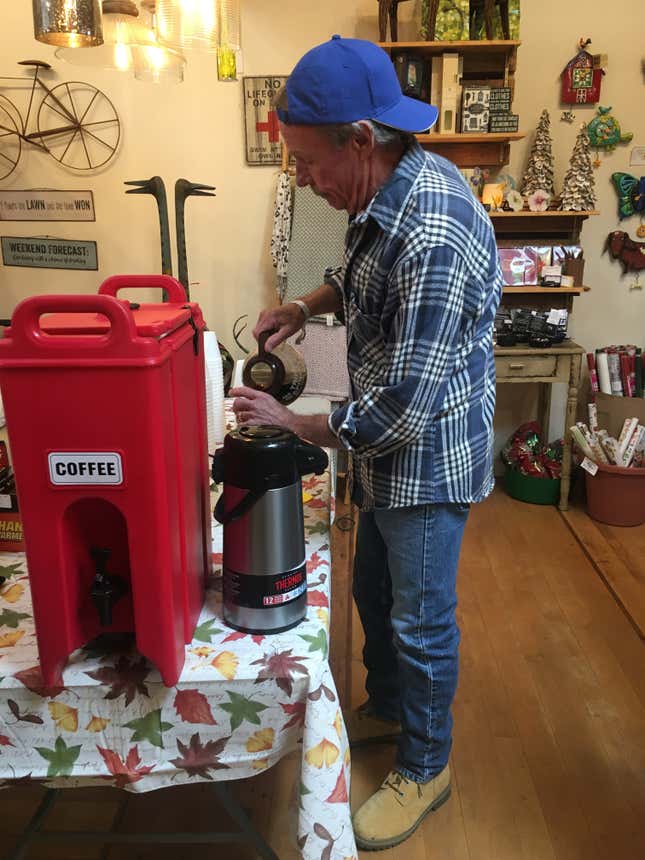
I met Dawn at the Washington Supply hardware/outdoor living store, where she now works. The store had set up a table and chairs resembling the set from Luke’s Diner in the window display, so that fans could come in and take photos—an ironic twist, given that the diner in the series is a refurbished hardware store. The owner, Dave Sedenick, donned Luke’s uniform—a backwards baseball cap and plaid shirt—while handing out free coffee. Fans loved it. Imperfect, but we had our Luke’s.
Styling Washington Depot to fit the fans’ image of Stars Hollow had introduced plenty of artifice. But for the most part, it didn’t feel particularly contrived or awkward. A children’s dance troupe from the next town over performed a slightly clumsy but charming recital, in a tribute to the many performances presided over by the flirtatious former Broadway performer Ms. Patty in the series. Liz Torres, the actress who played Ms. Patty in the show, was on hand.
Even the Living Arts show, put on by the local after-school program in a nod to the one that takes place in Stars Hollow, felt natural. Why wouldn’t children from this wealthy Connecticut area reenact Edvard Munch’s “The Scream” or Johannes Vermeer’s “Girl with the Pearl Earring” as part of their extracurricular activities? At times, I really did feel a part of the fictional, cozy world that so many fans of the show have yearned for.
I asked a number of locals for their opinion of how much Stars Hollow resembled everyday life in small-town Connecticut. Most of them said it was spot on, particularly when it came to colorful characters—and considering that Washington’s first selectman has a curlicued mustache, I tended to believe them.
Belonging in Stars Hollow
Of course, the world of Gilmore Girls is imperfect—and it definitely doesn’t feel so cozy to everyone. At the supermarket, I overheard one African-American man who’d been setting up festival tents tell the cashier that he “didn’t feel comfortable around locals.” “I’m waiting for someone to tell me I don’t belong here,” he said.
Tahira Williams, also African-American, told me, “The show isn’t a popular one in our culture.” I was standing with her and her friend when Pat Jordan, a retired teacher and psychoanalyst who was also African-American, ran up to us. “Ms. Patty is in the bookstore,” Jordan said, “and she asked me if there are any other women of color!”
The three women laughed about how few people of color there were at the festival—a situation mirrored in the show, which has drawn criticism for its lack of diversity, both in terms of race and sexual orientation. But this didn’t really bother Jordan, Williams or her friend Kimberly Evans. “The culture was so rich that you almost forgot,” said Williams.
That said, they noted that a lot of small Connecticut towns are fairly homogenous. “I was one of three [African-American] kids in my elementary school,” said Williams, who is from Stratford. “So it was very indicative of how my life was.”
For me, one of the most interesting things about the festival was being immersed in the world of Stars Hollow alongside its fictional inhabitants. None of the show’s major stars showed; the most high-profile actor from the series in attendance was Keiko Agena, who played Rory’s best friend, Lane Kim. But because even the minor roles in the show are finely detailed and familiar to the audience, the character actors who’d played them were treated as huge celebrities.
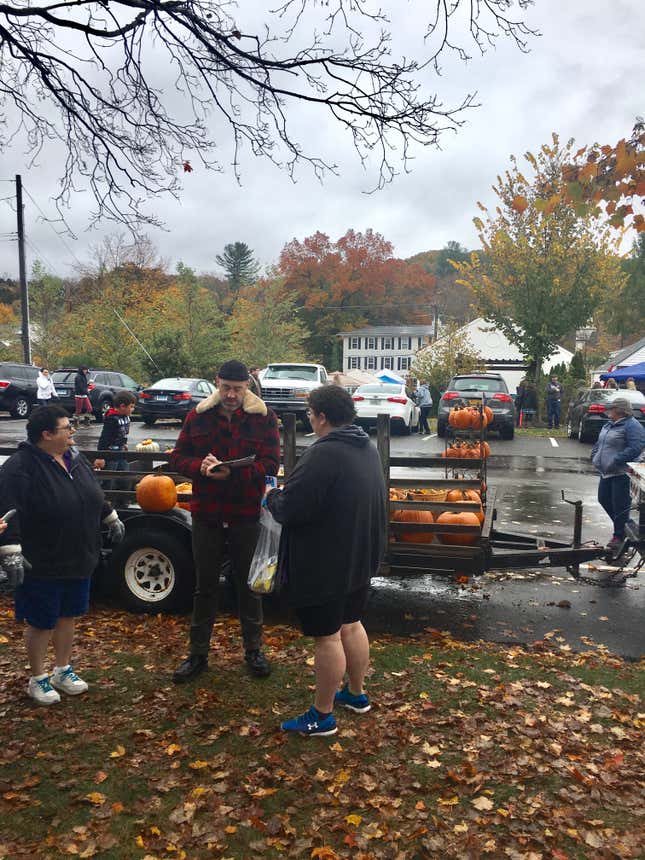
Torres, the actress who played Ms. Patty, had the same flair for drama as her fictional counterpart. She showed me her rings, each one symbolizing an award she’d been nominated for but hadn’t received. “This one is my Emmy,” she said, “this one is my Golden Globe.” Rose Abdoo, who played the auto mechanic Gypsy, was thrilled to discover that I was a Sagittarius. Jackson Douglas, who plays Melissa McCarthy’s farmer husband, looked like a hipster in his all-black clothes and lumberjack coat.
I asked Ted Rooney, the six-foot-six actor who plays cool cat Maury on the show, whether he’s ever experienced this much fan love. “Only today!” he replied. “I live a normal life in Portland, Oregon.” Even the show’s costumer, Valerie Campbell, was getting stopped for autographs. “It all feels like a family reunion,” said Evans, who said the show felt like “home” to her.
Having spent hundreds of hours watching the series, it was strange to observe that as soon as I started talking to the actors, their Gilmore Girls personas faded to the back of my mind. They became real people with whom I could discuss politics, the pitfalls and joys of Instagram, and who gave me poignant analysis of the show they’d been a part of. It was a bizarre moment of breaking through the fourth wall—especially when I got to tell them what had made the show so special to me. Torres, for example, seemed pleasantly surprised when I told her that for many nerdy, bookish girls, the character of Rory had offered long-awaited validation.
Many of the fans I spoke with at the festival had their own stories about how they had mapped the show onto their own experiences, problems, and relationships. Angie and Jeannie Ortiz, two sisters from Puerto Rico who are both law school graduates, said their traditional parents had hoped their daughters would focus on starting families instead of work. The show, which traced Rory’s dreams of becoming a foreign correspondent and Lorelai’s progress from maid to entrepreneur, gave them access to a feminist outlook on careers. “Every girl should watch this show,” Jeanie said.
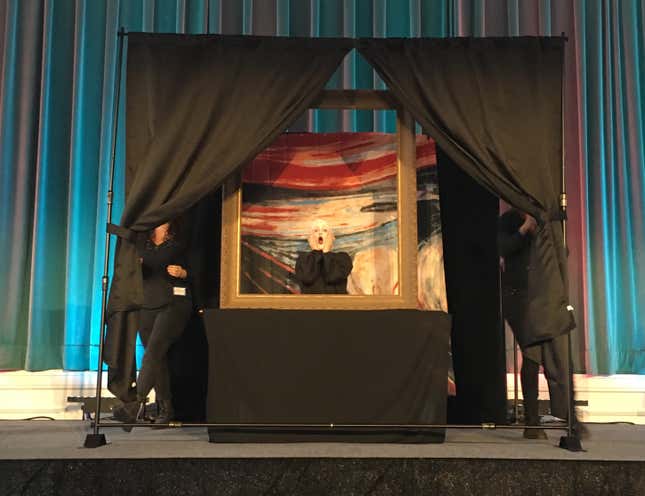
One young woman said the series had helped her feel more comfortable with her social life when she was a child, assuring her that having one strong friendship, as Rory did with Lane, was perfectly fine.
For me, the most important reference point in the show was the mother-daughter relationship. Like Rory, I was the daughter of a young, single mom raising a daughter essentially on her own. Gilmore Girls suggested that not only was this family model good enough, it could even be aspirational. Nothing on TV had really done that before.
The close rapport between Rory and Lorelai is a selling point for many moms and daughters. I witnessed a number of such pairs comparing themselves to the characters at the festival. I overheard one mother-daughter couple, for example, talking to each other in a strangely contrived fashion. The daughter, in her 30s, almost appeared to be performing in the vein of the show, launching into a fast-paced monologue about watching Doctor Zhivago and drinking wine. (“You can’t not drink a whole bottle of wine while watching it — it’s four hours!”)
Then I learned why. The pair explained that they’d had a rockier relationship in the past—less like Rory and Lorelai, and more like Lorelai’s difficult relationship with her own mother, Emily. The series brought them together when they stumbled upon it a little over a year ago. They finally had something in common. “It showed that it wasn’t too late to have a relationship,” the mother said. On Gilmore Girls, relationships are both relatable—when they are tough—and something to aspire to. Mothers and daughters can see both realistic and fantasized versions of themselves in Lorelai and Rory. And this can make their own relationships function just a little more smoothly.
I thought what I saw at the festival—the long conversations with the show’s stars, the behind-the-scenes info I learned from the cast panels—might ruin the Gilmore Girls fantasy for me. (The snow on the show is just paper and styrofoam!) But on Sunday afternoon, after I’d pulled an all-nighter with Gunn and Cabrera and driven back to the city in the wee hours of the morning, my boyfriend—a new fan—put an episode on. Carole King’s theme song, “Where You Lead,” gave me that same fuzzy feeling as it always did. Kirk was still Kirk, not the actor who plays him. And Stars Hollow was still a weird, fantastical place—a town that doesn’t quite exist in the real world, but that I’ll always keep coming back to.
